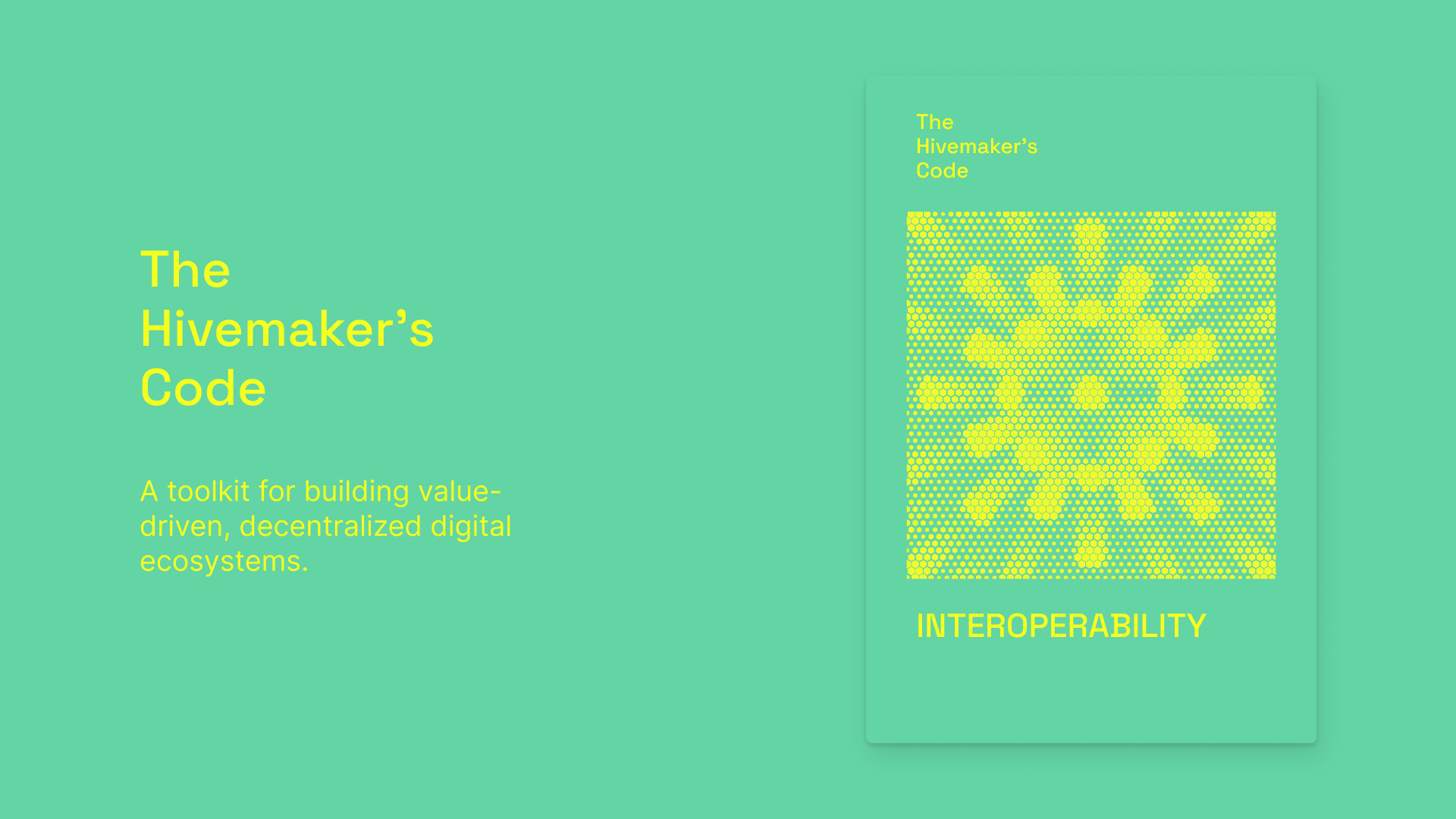This article is part of The Hivemaker’s Code series:
- Article 1: Introduction
- Article 2: How do Ecosystems Grow?
- Article 3: Cooperating on Blockchain
- Article 4: The Satoshi’s Dream
- Article 5: Anonymity in the Cryptosphere
- Article 6: Democracy and Decentralization
- Article 7: Is Net Neutrality Important for Blockchains?
- Article 8: Why Interoperability is the Bedrock of Digital Freedom
- Article 9: The Way Forward
How to Balance a Challenging Demand

Authors: Oliver Lukitsch, Michal Matlon, Gregor Žavcer, Thomas Fundneider, Markus Peschl, Lena Müller-Naendrup
Today, Tim Wu is a law professor at Columbia University and a White House official who advises the Biden administration on legal and economic issues. But in 2003, he was an associate professor at the University of Virginia Law School. Back then, he coined a term that still shapes the debate about fair use of the communications infrastructure and the Internet: “net neutrality.”
In a nutshell, net neutrality refers to a regulatory framework or environment in which internet service providers cannot prioritize traffic. Such traffic prioritization could help, for example, streaming services deliver their offer by paying internet service providers (ISPs) for more bandwidth. Yet, while some application providers will profit, traffic prioritization can discriminate against providers who cannot afford a higher bandwidth option.
Net neutrality proponents believe that it’s not possible to predict the winners of the most purposeful use of internet infrastructure. Instead, they say we should put our trust in fair competition. The best applications will emerge from there. That’s also the primary reasoning of any capitalist economy.
However, net neutrality is not a given. ISPs could create revenue by allowing certain web application providers to use greater bandwidth than others. Doing so makes sense for ISPs but will diminish competition and plurality. In other words, infrastructure must be neutral for its users to enable fair, inclusive, and accessible competition. Moreover, it must be neutral to drive innovation. At least, that is the reasoning of the proponents of net neutrality.
Does Neutrality Exist?
Wu’s notion got a lot of traction and evolved into the mantra of a global movement toward a free web. But isn’t neutrality a contradiction in itself? Infrastructure is owned by those who built it. Hence, the creators and operators of infrastructure establish a touch point for lobbying and influence. The ISPs are doing it more or less deliberately. This is too good an opportunity to ignore for streaming platforms and other services with high bandwidth requirements.
And this is why net neutrality can’t be solved purely by the market. Instead, it is considered the task of regulators to maintain a neutral network. Regulators must monitor and enforce network neutrality. Market intervention is necessary to provide for an open and accessible market.
Yet, as neutrality does not “take care of itself,” someone is always facing the question of being neutral. Are regulators neutral to begin with? Considering that no single_ _entity can convincingly claim to be genuinely neutral, could a distributed and collective entity, like the blockchain, solve the matter of neutrality better and more consistently?
The blockchain community is traditionally skeptical about top-down regulation, whether through state legislation or business giants wielding their influence. So how does the vision of an open and fair Web3 stand in the light of net neutrality? Does it have the means to establish and maintain neutrality on the protocol level? Or does it need to rely on external regulators and ISPs?
Does Net Neutrality Lessen the Potential of Blockchain?

We know that blockchain networks can suffer from congestion under load. The best example is an ICO (initial coin offering) of a new project entering the market. For instance, the ICO of the Bancor foundation issuing their BNT token clogged the Ethereum network for three hours.
Such problems can arise in the first place because of a blockchain’s nature as a distributed ledger. The distributed network of a blockchain consists of nodes that can span across the globe. While the internet functions as a server/client network, a blockchain is a peer-to-peer network.
This means when new blocks of transactions are added, they must be validated by most nodes. Nodes (in particular so-called “full nodes”) store the entire blockchain or the most recent blocks in their database and validate the addition of new blocks. Every node is included in adding new blocks, meaning that a single node with poor performance will exacerbate the entire network’s performance, according to Aleksandar Kuzmanovic, professor of computer science at Northwestern University and founder of bloXroute.
Moreover, as the nodes in a blockchain network are formed randomly, the data that propagates through the network cannot take an “optimal path.” The ability of any blockchain to counter congestion is limited because blockchains are distributed peer-to-peer networks, although this is being addressed with scalability efforts. All this raises the question of whether some form of “traffic prioritization” is necessary on the blockchain network for optimal performance.
Traffic Prioritization in Blockchain Networks

Such prioritization is already happening on certain blockchain networks. First and foremost, on the Bitcoin blockchain. This practice is called “paid prioritization.” Transactions on the blockchain can be prioritized for “monetary payoff,” allowing miners to put transactions that yield higher payoff into a “fast lane.” Transactions that deliver smaller rewards, on the other hand, will remain in the slow lane. This leads to rising fees in times of strong congestion.
Such prioritization is beneficial for keeping the network afloat as congestion and high bandwidth stress are discouraged. However, this is already a step toward undermining the network’s neutrality. Growing fees discriminate against users who cannot afford to use the fast lane network.
Hence, many consider blockchain networks antithetical to net neutrality. According to Jae Park, a professor of international education, the vision of blockchain contradicts the doctrine of net neutrality, as blockchains are typically “enclosed and not free of cost at all.”
The Feasibility of Net Neutrality in Blockchain Ecosystems
Blockchain networks have the advantage of being distributed peer-to-peer networks where data ownership, privacy, anonymity, and freedom of expression are protected by the unstoppability of the technology used.
Regardless, necessary traffic prioritization can turn its value proposition upside down. Interestingly, today’s internet has gotten around this problem by facing net neutrality regulations. It can, however, face these regulatory challenges specifically because_ _it features a centralized infrastructure, with all its downsides. So do we face the choice of net neutrality versus centralization? Can we only have one without the other?
Aleksandar Kuzmanovic suggests that blockchain technology can learn from how ISPs deal with the challenges of high bandwidth events without compromising its decentralized nature and thwarting its core value proposition.
According to Kuzmanovic, we can deploy distribution networks to solve this challenge. Content delivery networks (CDNs) and networks like Swarm help streaming services deal with demand peaks without compromising the user experience. In a blockchain, sending a block (every ten minutes in the case of Bitcoin) is a bottleneck.
However, content delivery networks are centralized systems. How can they be of use for a blockchain without undermining it? Moreover, nodes do not trust their immediate peers in a blockchain network, so how can they trust an entire CDN?
According to Kuzmanovic, the key to deploying CDNs in a blockchain is to make CDNs trustless. This is where net neutrality comes into play. Usually, when talking about net neutrality, we refer to ISPs who aim to monetize their services by prioritizing or discriminating against traffic.
Kuzmanovic claims that the problem can be turned upside down in the case of a blockchain. The content delivery network has to prove to the blockchain_ _that it is “neutral” and does not discriminate against certain types of content:
“First, the network should not be able to censor information based on the content of blocks. Second, the network should not be able to censor nodes. Third, nodes should be able to continuously audit the above properties, and in case of network misbehavior, to abandon and replace the network. Fourth, the network should be available for use by all nodes and miners.” (Aleksandar Kuzmanovic)”
An example for such a network is Swarm. It’s a network that cannot propagate or stop blocks based on their content, because the blocks are propagated only after_ _they are encrypted and shuffled. Thus, any node operator is capable of placing a file into the network and disseminating it, and no-one can stop it. Hence, the most powerful blockchain primitive is retained.
Conclusion

The distributed nature of blockchain raises concerns over its scalability while also challenging the neutrality of blockchain networks. It is a challenge centralized content providers have solved by deploying powerful distribution networks. But can blockchain networks learn from centralized solutions without compromising their core vision?
We saw that there are two solutions at our disposal. Blockchain networks can compromise on their neutrality by discriminating against users who cannot or don’t want to afford their traffic to be prioritized.
Some would argue that this approach does not compromise neutrality as miners do not discriminate against content but only prioritize those who, for instance, pay higher fees. For others, this is already a problem at the very heart of the net neutrality debate as the network prioritized traffic for profit.
On the other hand, a blockchain might take a firm stance against any violation of net neutrality, whether it’s discrimination against certain types of users, content, or paid traffic prioritization.
But, such an approach might come with a painful price tag. A permissionless blockchain that does not prioritize traffic is prone to congestion. And while centralized systems such as CDNs might be a solution to the problem, many proponents of the vision of decentralization will not be happy to compromise on their vision for making decentralized networks more resilient under high bandwidth stress.
We are yet to see which solutions will gain the upper hand and what the future of net neutrality will look like on Web3.
Key Insights

- Blockchain networks can deal with peak bandwidth events by prioritizing traffic.
- Net neutrality in decentralized peer-to-peer networks can make such networks prone to congestion.
- Centralized systems such as content distribution networks could safeguard net neutrality in blockchain networks at the expense of decentralization.
References

- Telecommunications Policy_ 44 (5): 101869. https://doi.org/10.1016/j.telpol.2019.101869.
- Nihalani, Ashvin. 2017. “Net Neutrality and the Blockchain.” Blockchain at Berkeley (blog). December 7, 2017. https://medium.com/blockchain-at-berkeley/net-neutrality-and-the-blockchain-22b17b3cad1.
- Park, Jae. 2021. “Promises and Challenges of Blockchain in Education.” Smart Learning Environments 8 (1): 33. https://doi.org/10.1186/s40561-021-00179-2.
- Siriwardena, Prabath. 2018. “The Mystery Behind Block Time.” Medium. July 8, 2018. https://medium.facilelogin.com/the-mystery-behind-block-time-63351e35603a.
- Team, bloXroute. 2019. “Why Net Neutrality Is the Key to Scaling Blockchains.”
- BloXroute Labs_ (blog). November 22, 2019. https://medium.com/bloxroute/why-net-neutrality-is-the-key-to-scaling-blockchains-865b9eeeac39.
Discussions about Swarm can be found on Reddit.
All tech support and other channels have moved to Discord!
Please feel free to reach out via info@ethswarm.org
Join the newsletter! .




